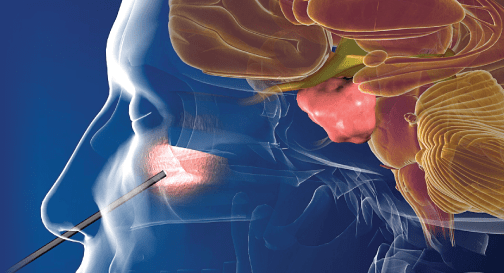Adenoma of the pituitary gland, a benign tumor, which is approximately 15-20% of all diagnosed neoplasms of the brain. The autopsies data show that about 20% of people have an adenoma of the pituitary gland, but in most cases the tumor is very small and does not adversely affect the body. If the neoplasm is large and hormonally active then it can result the malfunctioning of the adrenal glands, thyroid gland, and also of the reproductive function may be disrupted. Fortunately, today the pituitary adenoma is successfully treated. The doctors of MediGlobus mentioned about the most effective treatment methods and to what should be paid attention during treatment.
The key to successful treatment of pituitary adenoma
Treatment of pituitary adenoma requires an integrated approach. In addition to a neurosurgeon, a qualified endocrinologist and neurologist should also work with the patient.
A multidisciplinary approach is a guarantee that a maximally balanced decision will be taken and all aspects of the disease impact on the patient’s body will be taken into account. Working in the format of medical consilium is now the gold standard of practice in the best foreign clinics of Israel, Germany, Turkey and other countries where medicine is developed.
Also, the experience of a neurosurgeon is of great importance. Surgical operations to remove the tumor of the pituitary gland are quite complex and require high accuracy, skills and experience of a specialist. For example, the experience of leading neurosurgeons of the best foreign clinics exceeds 25 years, and if we talk about the number of neurosurgical operations performed, it is more than 200-300 per year.
Endoscopic endonasal trans-sphenoid surgery of pituitary adenoma

Endoscopic transnasal removal of pituitary adenoma is preferred in the leading clinics of the world, which is minimally traumatic method of surgery. Therefore, in majority of the cases, endoscopic transnasal resection of the pituitary adenoma is performed. The success rate of this procedure is 97% (with a tumor size within 2 cm), with virtually no complications.
The essence of the method is to remove tumor through the nasal cavity with the help of modern endoscopic equipment. Today, new endoscopes can provide complete visual control of the operation process in good quality and with a wide viewing angle.
To carry out the transnasal removal of adenoma, they DO NOT use a nasal dilator. Also, at this type of operation, traumatization of the nasal mucosa is excluded and there is no need for its subsequent nasal tamponade . Postoperative stay in a medical institution takes only 3 days (four times less than after an open surgery).
Gamma knife and Cyber Knife in the treatment of pituitary adenoma
Gamma Knife and Cyber Knife are radiosurgical devices, by which non-invasive treatment of pituitary adenoma is possible. Such therapy focuses on the targeted irradiation of neoplastic tissue, excluding the effect on healthy brain tissue. During the therapy, continuous monitoring is carried out. This is possible with MRI or CT scan. The procedure is painless and does not even require a hospital stay.
The principle of the Gamma Knife is also the targeted irradiation of the tumor. What is the difference then? This is often asked by patients. The difference is that the Cyber Knife can irradiate the tumor, during the movement of the organ. In case of Gamma Knife you need a clear fixation of the body.
That is why during the procedure the patient’s head is fixed with screws in the metal frame, which requires local anesthesia. Also, the Gamma Knife can irradiate only small tumors, on average up to 3 cm. If the neoplasm is 3-6 cm in size, therapy with Cyber Knife is prescribed.
Craniotomy with pituitary adenoma
Today trepanation of the skull, or craniotomy, for the purpose of removing the pituitary tumor is extremely rare – only 3% of cases. An open surgery is prescribed if the size of the lesion exceeds 10 cm.
The opening of the cranium is performed under general anesthesia. After surgery, the patient spends up to 24 hours in the ward of neurosurgical rehabilitation. Later in the hospital, the patient can stay for up to two weeks.
Radiation therapy and hormone therapy with pituitary adenoma
Hormone therapy is prescribed in combination with other methods of treatment. Most often it is recommended as a preliminary treatment before surgery. After surgery, radiation therapy is usually performed to irradiate the remaining malignant cells. Also, post-operative treatment can be supplemented with hormone therapy.
Therapy of pituitary adenoma with TrueBeam
The modern installation of TrueBeam combines the functions of radiotherapy with non-invasive radiosurgery. It is important that after treatment with this device, there are almost no complications of radiation. Cost of pituitary gland surgery is influenced by pricing policy of the clinic, activity of adenoma, size and location of the tumor, method of treatment.
TrueBeam significantly reduces the risk of negative impact on vulnerable areas around the tumor, for example, the structure of vision and the hypothalamus. It is this TrueBeam Stx that is the most effective device for treating a pituitary tumor that affects the cavernous sinus, which contains the nerves responsible for the movement of the eyeballs and the sensitivity of the face.
For detailed information on modern methods of treatment of pituitary adenomas, leave a message on the MediGlobus website. Our coordinating doctor will answer all your questions.






Comments